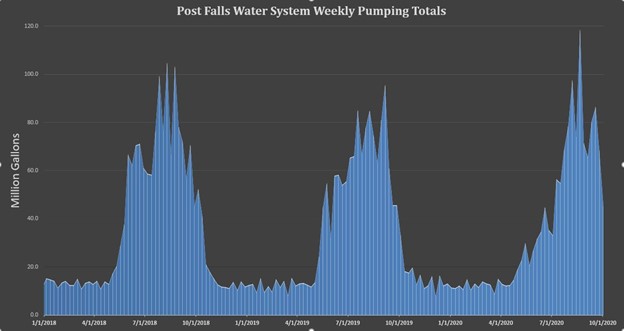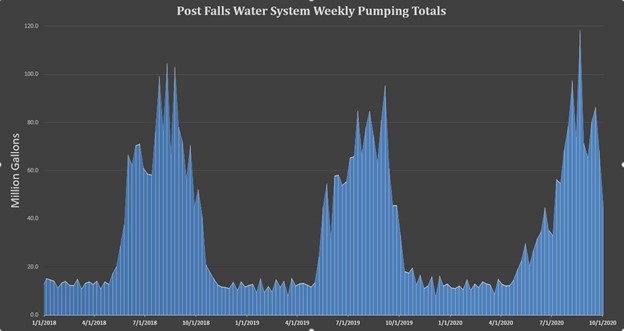We Don’t Pay for The Water We Use, We Pay for How We Use the Water
This story was written by Craig Borrenpohl and John Beacham, City of Post Falls, in partnership with the Our Gem Collaborative. It appeared in the CDA Press on Sunday, Oct. 10, 2021. Read the original article.
Contrary to what a utility bill might imply, we don’t actually pay for the water we use in northern Idaho. We, as citizens, already own the water we use; water in Idaho is a public trust resource.
We’ve all heard that wise use of water, including efficient irrigation, can save money, but it may provide more savings than a person might expect. Today’s focus is the stacked financial benefits of wise water use.
Of course, using less metered water will result in paying less on your monthly bill. This can be directly observed and needs little explanation. What may be less understood is that the flat fee and the per-gallon charges on a water bill are set based on the maximum or peak use of the community.
Public water systems have long served two main purposes – providing safe drinking water and a reliable water supply for firefighting; these are not always complementary. Rushing large volumes of water to a single point in a system, such as a fire hydrant, stresses the system and can pose a risk to the infrastructure and water quality. Luckily these risks can be accounted for with proper design. With this in mind, water providers are required to consider two worst case scenarios by regulating agencies. First, systems must be designed to provide the appropriate amount of water at each point in the system at any given time. This must be possible on the day of the year with the highest demand. Second, the water system must be able to provide water at the busiest hour and on the busiest day of the year.

Accomplishing these two goals requires a complex system of water supply (wells), water storage, and an appropriately sized system of pipes to distribute the water to each user of the system. Currently, water usage in our area is roughly ten times higher in the summer than in the winter. This means all of these systems are sized much bigger than would be necessary nine months out of the year.
Implementing water conservation measures, especially during the peak demand times, decreases the size of the infrastructure necessary to provide safe and reliable water to customers on any given day of the year. If this means no new wells (or fewer) are needed, no pipes require upgrading, or that existing storage meets the current and future needs, then none of those capital projects are required to be included in rate studies. Of course, there is a cost to maintaining existing infrastructure. However, that cost is stacked upon the additional costs if existing demand increases.
In most local systems, new customers are required to “buy-in” to the water systems. This means they pay a one-time fee for their share of investments made to meet the projected system demands. However, if each customer increases usage across the board (due to extreme heat events for example), upgrades to the systems will be required and will be built into future water rates. Conversely, if water usage in peak times decreases, water rates could fall compared with general inflation. Our patterns of use today drive the planning and design decisions of tomorrow; decreasing peak usage today can lead to paying less on every single water bill in the future.
Customers have power to influence their water rates. They exercise that power each time they make a decision to use water. We don’t pay for the water we use, we pay for how we use the water.







